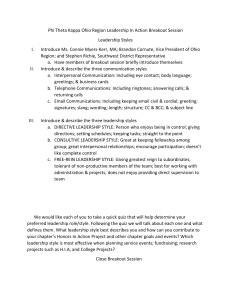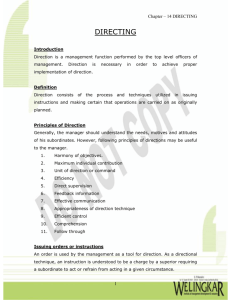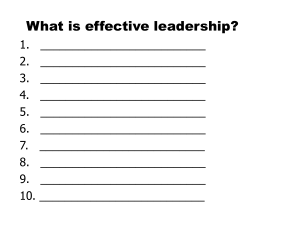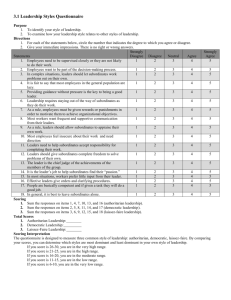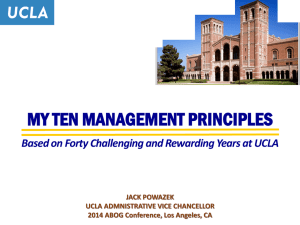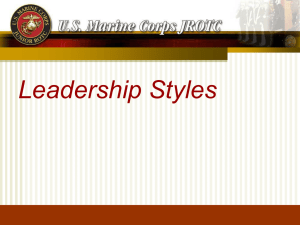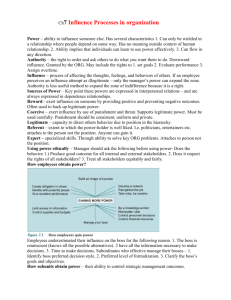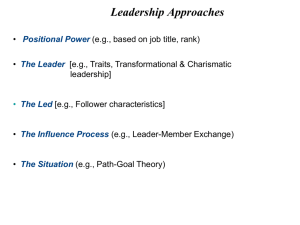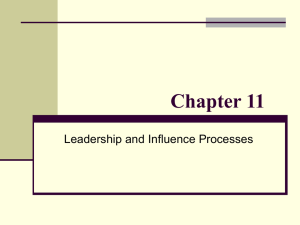Assessing Your Leadership Style
advertisement
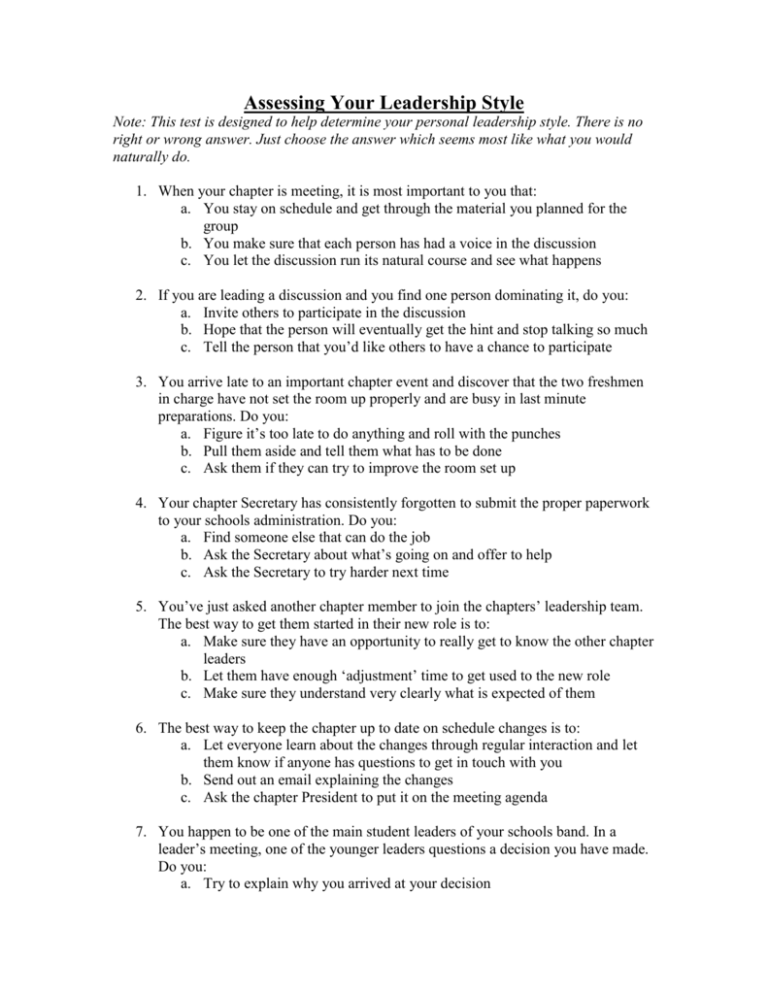
Assessing Your Leadership Style Note: This test is designed to help determine your personal leadership style. There is no right or wrong answer. Just choose the answer which seems most like what you would naturally do. 1. When your chapter is meeting, it is most important to you that: a. You stay on schedule and get through the material you planned for the group b. You make sure that each person has had a voice in the discussion c. You let the discussion run its natural course and see what happens 2. If you are leading a discussion and you find one person dominating it, do you: a. Invite others to participate in the discussion b. Hope that the person will eventually get the hint and stop talking so much c. Tell the person that you’d like others to have a chance to participate 3. You arrive late to an important chapter event and discover that the two freshmen in charge have not set the room up properly and are busy in last minute preparations. Do you: a. Figure it’s too late to do anything and roll with the punches b. Pull them aside and tell them what has to be done c. Ask them if they can try to improve the room set up 4. Your chapter Secretary has consistently forgotten to submit the proper paperwork to your schools administration. Do you: a. Find someone else that can do the job b. Ask the Secretary about what’s going on and offer to help c. Ask the Secretary to try harder next time 5. You’ve just asked another chapter member to join the chapters’ leadership team. The best way to get them started in their new role is to: a. Make sure they have an opportunity to really get to know the other chapter leaders b. Let them have enough ‘adjustment’ time to get used to the new role c. Make sure they understand very clearly what is expected of them 6. The best way to keep the chapter up to date on schedule changes is to: a. Let everyone learn about the changes through regular interaction and let them know if anyone has questions to get in touch with you b. Send out an email explaining the changes c. Ask the chapter President to put it on the meeting agenda 7. You happen to be one of the main student leaders of your schools band. In a leader’s meeting, one of the younger leaders questions a decision you have made. Do you: a. Try to explain why you arrived at your decision b. Ask the person to elaborate on why they question your decision c. Ask the person what decision they would have made 8. You discover that a member of you chapter has been openly critical of your leadership. Do you: a. Set up a meeting to discuss why this person has been critical b. Wait for the other person to bring it up to you directly c. Immediately meet with the person and confront them on their attitude 9. You are the chapter President and you have some strong thoughts on how to lead the chapter. However, your chapter sponsor disagrees. Do you: a. Allow a little time to go by and see if the sponsor changes their mind b. Ask the sponsor to suggest other alternatives that will work c. Tell your sponsor that you appreciate the other ideas, but you have strong reasons for your decision and that you need to be trusted 10. When solving a problem that affects others, do you: a. Present the problem, the solution and each person’s part in the implementation b. Discuss the problem and try to get everyone to agree on a common solution c. Trust that each person will solve their part of the problem that affects them 11. You are in charge of planning anchapter fundraiser. Do you: a. Encourage spontaneous meetings to discuss plans b. Check to see that everyone knows what to do c. Let people get in touch with you if they have any questions 12. In establishing a committee to plan an event it is best to: a. Allow the committee to function at their own pace b. Ask the committee to establish their own timeline after they understand the objectives c. Give the committee clearly defined objectives, a timeline and standards of operating 13. The best way to handle a difference in opinion between two members in your chapter is to: a. State the differences of opinion and present a compromise position that both can accept b. Encourage the two to meet together and work out their differences c. Bring the two people together and help them arrive at a solution 14. In a group of friends, do you; a. Try to make sure everyone has been heard b. Enjoy listening to the ideas of others c. Easily offer your opinion Scoring the Leadership Profile Question Directive Consultative Free Rein 1 A_____ B_____ C_____ 2 C_____ A_____ B_____ 3 B_____ C_____ A_____ 4 A_____ B_____ C_____ 5 C_____ A_____ B_____ 6 B_____ C_____ A_____ 7 A_____ B_____ C_____ 8 C_____ A_____ B_____ 9 C_____ B_____ A_____ 10 A_____ B_____ C_____ 11 B_____ A_____ C_____ 12 C_____ B_____ A_____ 13 A_____ C_____ B_____ 14 C_____ A_____ B_____ TOTAL ________ ________ ________ My natural leadership style is:___________________________________ DIRECTIVE LEADERSHIP STYLE 1. In challenging situations, you feel most comfortable working from clear guidelines. 2. In meetings, you take charge early and become anxious to get down to business. 3. You find it easy to assign tasks, provide schedules, and monitor progress. 4. You may tend to become impatient when subordinates want to prolong a discussion. You tend to be more concerned with getting the job done than you are with meeting interpersonal needs. 5. In situations in which you have complete control you tend to relax more, assume an easy-going manner, and become more patient and considerate. CONSULTIVE LEADERSHIP STYLE 1. The primary goal is to have good interpersonal relations with others-even at the sacrifice of the goal. 2. You tend to be very sensitive to the individual members of the group and are especially concerned with their feelings. 3. In a meeting you tend to encourage the participation of various members of the group. 4. In high stress situations you tend to find it more difficult to reach the goal. 5. You function best in moderate control situations where you are able to deal with interpersonal relations and deal effectively with difficult subordinates. FREE-REIN LEADERSHIP STYLE 1. In challenging situations, you allow the greatest freedom to your subordinates. 2. You can become overly tolerant of non-productive members of your team. 3. Your “best” day is one in which you have spent the majority of your time working on projects and administrative functions. 4. You schedule meetings, but may tend to have a difficult time bringing the discussion to any definitive conclusion or implementation plan. 5. You tend to function best with subordinates who enjoy working on their own and need little day-to-day supervision from you. Comparison of Leadership Styles Area of Concern Directive (Control Orientated) Consultative (Team Approach) Free Rein (LaissezFaire) Who does the planning? Leader Leader plus group Individuals or groups Who does the Problem Solving? Leader Leader plus group Individuals or groups Who makes decisions? Leader Leader plus group Individuals or groups Down Down, up and across Across Where is the responsibility for achievement felt? Leader Leader plus group Not Felt Where does the responsibility actually lie? Leader Leader Leader Leader’s confidence level in subordinates Little to none High High Leader’s rapport with subordinates Low High Questionable Amount of delegation of authority by leader None Lots Lots Crisis Management Good Poor Chaotic Change Management Poor Good Ineffective What is the direction of communication? Behaviors That Work For and Against Leadership Selection The behavioral approach to leadership suggests that people can behave in ways that may lead to their being selected as leaders or distinguish them as leaders. This is similar to the trait approach, except that traits are considered more or less inborn attributes, while behaviors can be learned and refined. The list below shows behaviors that have been identified as being related to being selected or not selected as a leader in groups. Contributing Behaviors high participation and talking comfort and fluency in delivering information forceful and energetic in presentation does not express strong opinions early in group (can later) initiates conversation introduces new themes and topics seeks comments from others (Gatekeeper role) sits at head of table in a position of receiving, dispensing, or coordinating information avoids obviously persuading other to a point of view interacts flexibly with others; changes style as needed but not seen as chameleon promotes identity of group ("we, us, our", etc.) listens accurately to other's contributions demonstrates achievement, goal orientation and task structure Interfering Behaviors low level of participation, involvement or contribution uninformed contribution overly directive comments offensive language (including sexist and profanity) stilted, overly formal language dominates conversation absent from meetings volunteers as secretary or recorder of meetings takes role of joker shows contempt for leadership willing to do as told presents self too strongly early in group discussion Go back over the above lists and reflect on the differences between them. What are the principles involved? What makes a person desirable or undesirable as a leader based on behavior?
